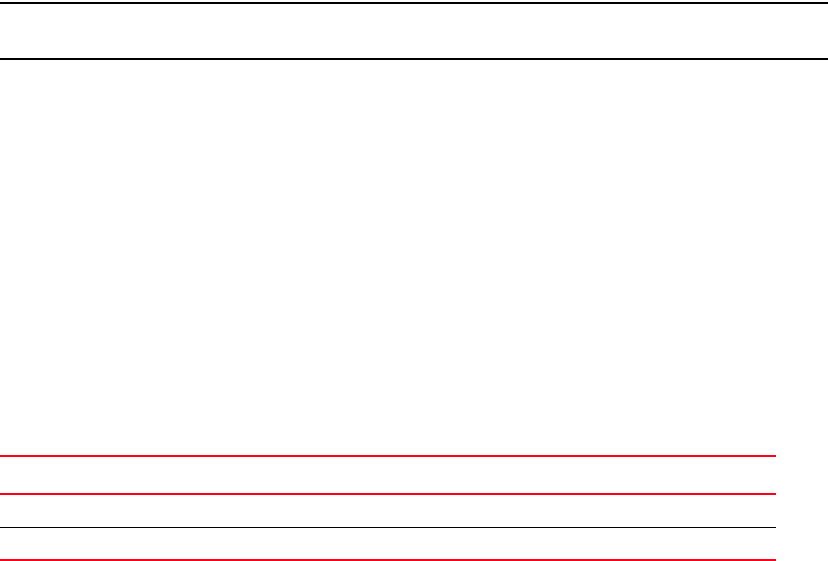Brocade Converged Enhanced Ethernet Administrator's Guide v6.1.2_cee (53-1001258-01, June 2009)
Table Of Contents
- Contents
- Figures
- Tables
- About This Document
- Introducing FCoE
- Using the CEE CLI
- In this chapter
- CEE CLI configuration guidelines and restrictions
- Using the CEE command line interface (CLI)
- CEE CLI RBAC permissions
- Accessing the CEE CLI through the console interface or through a Telnet session
- Accessing the CEE CLI from the Fabric OS shell
- Accessing CEE CLI command modes
- Using CEE CLI keyboard shortcuts
- Displaying CEE CLI commands and command syntax
- Using CEE CLI command completion
- CEE CLI command syntax conventions
- Using CEE CLI command output modifiers
- Configuring VLANs Using the CEE CLI
- In this chapter
- VLAN overview
- Ingress VLAN filtering
- VLAN configuration guidelines and restrictions
- Default VLAN configuration
- VLAN configuration procedures
- Enabling and disabling a CEE interface
- Configuring the MTU on a CEE interface
- Creating a VLAN interface
- Configuring a VLAN interface to forward FCoE traffic
- Configuring a CEE interface as a Layer 2 switch port
- Configuring a CEE interface as an access interface or a trunk interface
- Configuring VLAN classifier rules
- Configuring VLAN classifier groups
- Associating a VLAN classifier group to a CEE interface
- Clearing VLAN counter statistics
- Displaying VLAN information
- Configuring the MAC address table
- Configuring STP, RSTP, and MSTP using the CEE CLI
- In this chapter
- STP overview
- RSTP overview
- MSTP overview
- STP, RSTP, and MSTP configuration guidelines and restrictions
- Default STP, RSTP, and MSTP configuration
- STP, RSTP, and MSTP configuration procedures
- STP, RSTP, and MSTP-specific configuration procedures
- STP and RSTP-specific configuration procedures
- RSTP and MSTP-specific configuration procedures
- MSTP-specific configuration procedures
- 10-Gigabit Ethernet CEE interface-specific configuration
- Global STP, RSTP, and MSTP-related configuration procedures
- Clearing STP, RSTP, and MSTP-related information
- Displaying STP, RSTP, and MSTP-related information
- Configuring Link Aggregation using the CEE CLI
- Configuring LLDP using the CEE CLI
- Configuring ACLs using the CEE CLI
- In this chapter
- ACL overview
- Default ACL configuration
- ACL configuration guidelines and restrictions
- ACL configuration procedures
- Creating a standard MAC ACL and adding rules
- Creating an extended MAC ACL and adding rules
- Modifying a MAC ACL
- Removing a MAC ACL
- Reordering the sequence numbers in a MAC ACL
- Applying a MAC ACL to a CEE interface
- Applying a MAC ACL to a VLAN interface
- Clearing MAC ACL counters
- Displaying MAC ACL information
- Configuring QoS using the CEE CLI
- Configuring FCoE using the Fabric OS CLI
- Administering the switch
- Configuring RMON using the CEE CLI
- Index

124 Converged Enhanced Ethernet Administrator’s Guide
53-1001258-01
FCoE configuration procedures
9
• FCoE ports are displayed in FC show commands and use the FC port numbering scheme.
However, configuration of the FCoE ports through the regular FC CLI is disabled, only the fcoe
CLI commands can be used to configure the FCoE ports.
• FCoE-specific Fabric OS CLI commands are provided for the configuration and management of
the six FCoE ports (for detailed information on these ports, see “Logical connectivity” on
page 4).
The six FCoE ports can be displayed as follows:
switch:admin> fcoe --cfgshow
Slot User Port Status Trunk WWN DeviceCount Trunk Type Peer MAC
=============================================================================
=
0 8 ENABLED 20:08:00:05:1e:12:d0:03 0 FCOE F-Port
0 9 ENABLED 20:09:00:05:1e:12:d0:03 0 FCOE F-Port
0 10 ENABLED 20:0a:00:05:1e:12:d0:03 0 FCOE F-Port
0 11 ENABLED 20:0b:00:05:1e:12:d0:03 0 FCOE F-Port
0 12 ENABLED 20:0c:00:05:1e:12:d0:03 0 FCOE F-Port
0 13 ENABLED 20:0d:00:05:1e:12:d0:03 0 FCOE F-Port
FCoE configuration procedures
In this section:
•Managing and displaying the FCoE configuration. . . . . . . . . . . . . . . . . . . . 124
•Managing and displaying the FCoE login configuration . . . . . . . . . . . . . . . 126
•Creating and managing the FCoE login group configuration . . . . . . . . . . . 128
NOTE
To assist you in configuring FCoE, see “FCoE Initialization Protocol (FIP)” on page 11.
Managing and displaying the FCoE configuration
In this section:
•Enabling or disabling an FCoE port . . . . . . . . . . . . . . . . . . . . . . . . . . . . . . . 124
•Configuring FCMAP values for a VLAN . . . . . . . . . . . . . . . . . . . . . . . . . . . . . 125
•Configuring FIP multicast advertisement intervals . . . . . . . . . . . . . . . . . . . 125
•Clearing logins . . . . . . . . . . . . . . . . . . . . . . . . . . . . . . . . . . . . . . . . . . . . . . . . 125
•Displaying FCoE configuration-related information. . . . . . . . . . . . . . . . . . . 126
Enabling or disabling an FCoE port
Perform the following tasks to enable or disable an FCoE port:
Task Command
Enable an FCOE port. switch:admin> fcoe --enable port
Disable an FCOE port. switch:admin> fcoe --disable port










